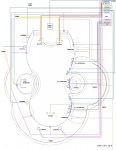I have a plumber coming in this weekend to walk me through the equipment setup and the pad.
I have little experience with this type of work and was hoping someone knowledgeable could help me understand what to look for with regard to pumps, filter, heater, booster pump, blower, diverter valves, ball valves, check valves, actuators, etc. - particularly placement and design.
I have attached a layout of the pool features
Any help appreciated !!!!!!!
I have little experience with this type of work and was hoping someone knowledgeable could help me understand what to look for with regard to pumps, filter, heater, booster pump, blower, diverter valves, ball valves, check valves, actuators, etc. - particularly placement and design.
I have attached a layout of the pool features
Any help appreciated !!!!!!!


